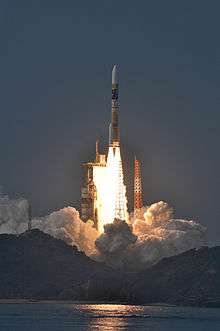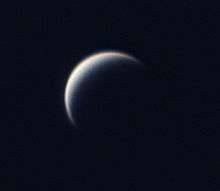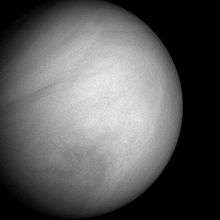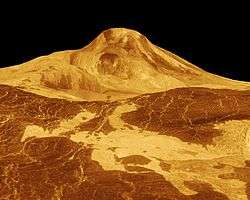Akatsuki (spacecraft)
 Artist's concept of the Akatsuki spacecraft in orbit around Venus | |
| Mission type | Venus orbiter |
|---|---|
| Operator | JAXA |
| COSPAR ID | 2010-020D |
| SATCAT № | 36576 |
| Website |
JAXA JAXA Special Site |
| Mission duration |
~2 years (science phase) elapsed: 6 years, 6 months and 15 days |
| Spacecraft properties | |
| Manufacturer | NEC Space Technologies |
| Launch mass | 517.6 kg (1,141 lb)[1] |
| Dry mass | 320 kg (710 lb) |
| Power | >700 watts at 0.7 AU[1] |
| Start of mission | |
| Launch date | 20 May 2010, 21:58:22 UTC[2] |
| Rocket | H-IIA 202 |
| Launch site | Tanegashima Yoshinobu 1 |
| Orbital parameters | |
| Reference system | Cytherocentric |
| Pericytherion | 400 kilometres (250 mi) |
| Apocytherion | 440,000 kilometres (270,000 mi) |
| Inclination | 3° |
| Period | 9 days[3] |
| Flyby of Venus (failed insertion) | |
| Closest approach | 6 December 2010, 23:49:00 UTC |
| Venus orbiter | |
| Orbital insertion | 7 December 2015[4][5] |
Akatsuki (あかつき, 暁, "Dawn"), also known as the Venus Climate Orbiter (VCO) and Planet-C, is a Japanese (JAXA) space probe tasked to study the atmosphere of Venus. It was launched aboard an H-IIA 202 rocket on 20 May 2010,[6] and failed to enter orbit around Venus on 6 December 2010. After the craft orbited the Sun for five years, engineers placed it into an alternative elliptical Venusian orbit on 7 December 2015 by firing its attitude control thrusters for 20 minutes.[4][5][7][8] By using five different cameras, Akatsuki will study the stratification of the atmosphere, atmospheric dynamics, and cloud physics.[9][10]
Mission
Akatsuki is a Japanese space mission to the planet Venus. Planned observations include cloud and surface imaging from an orbit around the planet with an infrared camera, which are aimed at investigation of the complex Venusian meteorology. Other experiments are designed to confirm the presence of lightning and to determine whether volcanism occurs currently on Venus.[11] In most planets, the atmosphere circulates much slower than the rotation speed of the planet. However, on Venus, while the planet rotates at 6 km/h at the equator, the atmosphere spins around the planet at 300 km/h.
Akatsuki is Japan's first planetary exploration mission since the failed Mars orbiter Nozomi probe which was launched in 1998. Akatsuki was originally intended to conduct scientific research for two or more years from an elliptical orbit around Venus ranging from 300 to 80,000 km (190 to 49,710 mi) in altitude,[1] but its alternate orbit, yet to be characterized, had to be highly elliptical. The budget for this mission is ¥14.6 billion (US$174 million) for the satellite and ¥9.8 billion (US$116 million) for the launch.[12]
Spacecraft design
The main bus is a 1.45 × 1.04 × 1.44 m (4.8 × 3.4 × 4.7 ft) box with two solar arrays, each with an area of about 1.4 m2 (15 sq ft). The solar arrays provide over 700 W of power in Venus orbit. The total mass of the spacecraft at launch was 517.6 kg (1,141 lb).[1] The mass of the science payload is 34 kg (75 lb).[13]
Propulsion is provided by a 500-newton (110 lbf) bi-propellant, hydrazine-dinitrogen tetroxide orbital maneuvering engine and twelve mono-propellant hydrazine reaction control thrusters, eight with 23 N (5.2 lbf) of thrust and four with 3 N (0.67 lbf). It is the first spacecraft to use a ceramic (silicon nitride) retrofire thruster. The total propellant mass at launch was 196.3 kg (433 lb).[1]
Communication is via an 8 GHz, 20-watt X-band transponder using the 1.6 m (5 ft 3 in) high-gain antenna. The high-gain antenna is flat to prevent heat from building up in it.[10] Akatsuki also has a pair of medium-gain horn antennas mounted on turntables and two low-gain antennas for command uplink. The medium-gain horn antennas are used for housekeeping data downlink when the high-gain antenna is not facing Earth.[1]
Instruments
The scientific payload consists of six instruments. The five imaging cameras will explore Venus in wavelengths from ultraviolet to the mid-infrared:[14][15]
- the Lightning and Airglow Camera (LAC) will look for lightning in the visible wavelengths of 552 to 777 nanometers
- the ultraviolet imager (UVI) will study the distribution of specific atmospheric gases such as sulfur dioxide in ultraviolet wavelengths (293–365 nm)
- the longwave infrared camera (LIR) will study the structure of high-altitude clouds at a wavelength where they emit heat (10 μm)
- the 1 μm camera (IR1) will image heat radiation emitted from Venus's surface rocks (0.90–1.01 μm) and will help researchers to spot active volcanoes, if they exist
- the 2 μm camera (IR2) will detect heat radiation emitted from the lower reaches of the atmosphere (1.65–2.32 μm)
- the Ultra-Stable Oscillator (USO) for high precision measurement of distance and communication
Public relations
A public relations campaign was held between October 2009 and January 2010 by the Planetary Society and JAXA, to allow individuals to send their name and a message aboard Akatsuki.[16][17] Names and messages were printed in fine letters on an aluminium plate and placed aboard Akatsuki.[16] 260,214 people submitted names and messages for the mission.[18] Around 90 aluminium plates were created for the spacecraft,[19] including three aluminium plates in which the images of the Vocaloid Hatsune Miku and her super deformed figure Hachune Miku were printed.[20]
Operations
Launch

Akatsuki left the Sagamihara Campus on 17 March 2010, and arrived at the Tanegashima Space Center's Spacecraft Test and Assembly Building 2 on 19 March. On 4 May, Akatsuki was encapsulated inside the large payload fairing of the H-IIA rocket that launched the spacecraft, along with the IKAROS solar sail, on a 6-month journey to Venus. On 9 May, the payload fairing was transported to the Tanegashima Space Center's Vehicle Assembly Building, where the fairing was mated to the H-IIA launch vehicle itself.[21]
The spacecraft was launched on 20 May 2010 at 21:58:22 (UTC) from the Tanegashima Space Center,[11] after being delayed because of weather from its initial 18 May scheduled target.[22]
Orbit insertion failure
Akatsuki was planned to initiate orbit insertion operations by igniting the orbital maneuvering engine at 23:49:00 on 6 December 2010 UTC.[21] The burn was supposed to continue for twelve minutes, to an initial Venus orbit with an apoapsis of 180,000 to 200,000 km (110,000 to 120,000 mi), a periapsis of 550 km (340 mi), and a four-day orbital period.[23]
The orbit insertion maneuver was confirmed to have started on time, but after the expected blackout due to occultation by Venus, the communication with the probe did not recover as planned. The probe was found to be in safe-hold mode, spin-stabilized state with ten minutes per rotation.[24] Due to the low communication speed through the low-gain antenna, it took a while to determine the state of the probe.[25] JAXA stated on 8 December that the probe's orbital insertion maneuver had failed.[26][27] At a press conference on 10 December, officials reported that Akatsuki's engines fired for less than three minutes, far less than what was required to enter into Venus orbit.[28] Further research found that the likely reason for the probe malfunction was salt deposits jamming the valve between the helium pressurization tank and the fuel tank. As a result, engine combustion became oxidizer-rich, with resulting high combustion temperatures damaging the combustion chamber throat and nozzle. A similar vapor leakage problem destroyed the NASA Mars Observer probe in 1993.[29]
Recovery efforts
JAXA developed plans to attempt another orbital insertion burn when the probe returned to Venus in December 2015. This required placing the probe into "hibernation" or safe mode to prolong its life beyond the original 4.5-year design. JAXA expressed some confidence in keeping the probe operational, pointing to reduced battery wear, since the probe was then orbiting the Sun instead of its intended Venusian orbit.[30]
Telemetry data from the original failure suggested that the throat of its main engine, the orbit maneuver engine (OME) was still largely intact, and trial jet thrusts of the probe's onboard OME were performed twice, on 7 and 14 September 2011.[21] However, the thrust was only about 40 newtons (9.0 lbf), which was 10% of expectations. Following these tests, it was determined that insufficient specific impulse would be available for orbital maneuvering by the OME. It was concluded that the remaining combustion chamber throat was completely destroyed by transient ignition of the engine. As a result, the selected strategy was to use four hydrazine attitude control thrusters, also called reaction control system (RCS), to drive the probe into orbit around Venus. Because the RCS thrusters do not need oxidiser, the remaining 65 kg of oxidiser (MON) was vented overboard in October 2011 to lighten the spacecraft.[29]
Three peri-Venus orbital maneuvers were executed on 1 November,[11] 10 and 21 November 2011 using the RCS thrusters. A total delta-v of 243.8 m/s was imparted to the spacecraft. Because the RCS thrusters' specific impulse is low compared to the specific impulse of the OME, the previously planned insertion into low Venusian orbit became impossible. Instead, the new plan was to place the probe in a highly elliptical orbit with an apoapsis of a hundred thousand kilometers and a periapsis of a few thousand kilometers from Venus. Engineers planned for the alternate orbit to be prograde (in the direction of the atmospheric super-rotation) and lie in the orbital plane of Venus. The method and orbit were announced by JAXA in February 2015, with an orbit insertion date of 7 December 2015.[31] The probe reached its most distant point from Venus on 3 October 2013 and had been approaching the planet since then.[32]
Orbit insertion
After performing the last of a series of four trajectory correction maneuvers between 17 July and 11 September 2015, the probe was established on a rendezvous trajectory with Venus. The rendezvous occurred on 7 December 2015, when Akatsuki successfully entered Venus orbit after a 20-minute burn with 4 thrusters that were not rated for such a hefty propulsive maneuver.[4][5][33] Instead of taking about 30 hours to complete an orbit around Venus—as was originally planned—Akatsuki will complete one orbit every nine days after an adjustment in March 2016.[3]
After JAXA engineers measured and calculated its orbit following the December 7 operation, JAXA announced on December 9 that Akatsuki had successfully entered the intended elliptical orbit, as far as 440,000 km (270,000 mi) from Venus, and as close as 400 km (250 mi) from Venus's surface with an orbital period of 13 days and 14 hours.[34]
Status
A follow-up thruster burn on 26 March 2016 lowered Akatsuki's apoapsis to about 330,000 km (210,000 mi) and shortened its orbital period from 13 to 9 days.[3] The orbiter started its 2-year period of "regular" science operations in mid-May 2016.[35]
See also
- Ikaros, solar sail demonstrator, launched along with Akatsuki
- List of missions to Venus
- Nozomi (probe), 1998 Mars mission (did not enter orbit)
- Sakigake, Japan's first interplanetary probe, 1985
- Suisei (probe)
- Venus probes
References
- 1 2 3 4 5 6 Takeshi, Oshima; Tokuhito, Sasaki. "Development of the Venus Climate Orbiter PLANET-C (AKATSUKI)". NEC Technical Journal. 6 (1): 47–51.
- ↑ Stephen Clark (20 May 2010). "H-2A Launch Report – Mission Status Center". Spaceflight Now. Archived from the original on 20 May 2010. Retrieved 20 May 2010.
- 1 2 3 "Japanese probe fires thrusters in second bid to enter Venus orbit". The Japan Times. 7 December 2015. Retrieved 7 December 2015.
- 1 2 3 Szondy, David. "Akatsuki probe enters orbit around Venus". Retrieved 7 December 2015.
- 1 2 3 Clark, Stephan. "Japanese probe fires rockets to steer into orbit at Venus". Retrieved 7 December 2015.
- ↑ Chris Bergin (20 May 2010). "AXA H-IIA carrying Akatsuki and IKAROS launches at second attempt". NASASpaceFlight. Retrieved 19 November 2010.
- ↑ Limaye, Sanjay. "Live from Sagamihara: Akatsuki Orbit Insertion – Second Try". Retrieved 7 December 2015.
- ↑ Wenz, John (21 September 2015). "Japan's Long Lost Venus Probe May Boom Back to Life". Popular Mechanics. Retrieved 14 October 2015.
- ↑ Nakamura, N.; et al. (May 2011). "Overview of Venus orbiter, Akatsuki". Earth, Planets and Space. 63 (5): 443–457. doi:10.5047/eps.2011.02.009. ISSN 1880-5981.
- 1 2 "Exploring the Venusian Atmosphere – AKATSUKI/PLANET-C". Akatsuki Special Site. Retrieved 5 December 2015.
- 1 2 3 "AKATSUKI orbit control at perihelion". JAXA. 1 November 2011. Retrieved 3 December 2011.
- ↑ Staff writers (8 December 2010). "Japan probe shoots past Venus, may meet again in six years". Spacedaily.com. Retrieved 3 December 2011.
- ↑ "Mission overview". PLANET-C Team/JAXA. Retrieved 3 December 2011.
- ↑ "Akatsuki (Venus Climate Orbiter / Planet-C)". The Planetary Society. Retrieved 19 November 2010.
- ↑ Nakamura, Masato; Imamura, Takeshi; Ueno, Munetaka; et al. "Planet-C: Venus Climate Orbiter mission of Japan" (pdf). Planetary and Space Science. 55 (12): 1831–1842. Bibcode:2007P&SS...55.1831N. doi:10.1016/j.pss.2007.01.009.
- 1 2 "Messages From Earth: Send your Message to Venus on Akatsuki". The Planetary Society. 2010. Archived from the original on 7 April 2010. Retrieved 2 April 2010.
- ↑ "We will deliver your message to the bright star Venus – Akatsuki Message Campaign". JAXA. Retrieved 19 November 2010.
- ↑ "AKATSUKI Message Campaign". JAXA. 2010. Retrieved 2 April 2010.
- ↑ 金星へ届け! 県民が寄せ書き [Hoping that It Will Reach Venus! Residents of The Prefecture Write Something Together] (in Japanese). Oita Godo Shimbum. 17 May 2010. Retrieved 20 July 2010.
- ↑ "打ち上げを目前に控えた「あかつき」と「IKAROS」の機体が公開" [The Airframes of "Akatsuki" And "IKAROS" just before Those Launch Are Opened]. Mycom Journal (in Japanese). Mainichi Communications. 12 March 2010. Retrieved 20 July 2010.
- 1 2 3 "Venus Climate Orbiter "AKATSUKI" (PLANET_C): Topics". JAXA. 1 November 2011. Retrieved 3 December 2011.
- ↑ "Launch of Venus probe Akatsuki postponed due to bad weather". Japan Today. 18 May 2010. Retrieved 19 November 2010.
- ↑ 来月7日に金星周回軌道へ=あかつき、エンジン噴射−7年前は火星で失敗・宇宙機構. Jiji.com (in Japanese). Jiji Press. 18 November 2010. Retrieved 5 December 2010.
- ↑ 金星探査機「あかつき」の状況について [About the State of Venus Probe Akatsuki] (PDF) (in Japanese). 7 December 2010. Retrieved 7 December 2010.
- ↑ JAXA's press briefing, 22:00, 7 December 2010 JST
- ↑ "Japan's Venus Probe Fails to Enter Orbit". ABC News. Retrieved 8 December 2010.
- ↑ "Akatsuki Mission statement". The Planetary Society. Retrieved 8 December 2010.
- ↑ David Cyranoski (14 December 2010). "Venus miss is a setback for Japanese programme". Nature. Retrieved 21 December 2010.
- 1 2 Nakamura, M.; Kawakatsu, Y.; Hirose, C.; Imamura, T.; Ishii, N.; Abe, T.; Yamazaki, A.; Yamada, M.; Ogohara, K.; Uemizu, K.; Fukuhara, T.; Ohtsuki, S.; Satoh, T.; Suzuki, M.; Ueno, M.; Nakatsuka, J.; Iwagami, N.; Taguchi, M.; Watanabe, S.; Takahashi, Y.; Hashimoto, G. L.; Yamamoto, H. (2014). "Return to Venus of the Japanese Venus Climate Orbiter AKATSUKI". Acta Astronautica. 93: 384–389. Bibcode:2014AcAau..93..384N. doi:10.1016/j.actaastro.2013.07.027.
- ↑ "Japanese Venus Probe Misses Orbit". Aviation Week & Space Technology.
- ↑ "Japanese craft to get second chance after missing Venus in 2010".
- ↑ 「あかつき」の旅 (2013年特別公開向け資料) (PDF) (in Japanese). PLANET-C Team/JAXA. 26 August 2013. Retrieved 8 June 2014.
- ↑ "AKATSUKI: Orbit successfully controlled". PLANET-C Team/JAXA. 5 August 2015. Retrieved 10 September 2015.
- ↑ "Venus Climate Orbiter "AKATSUKI" Inserted Into Venus' Orbit". JAXA. December 9, 2015.
- ↑ Clark, Steven (17 May 2016). "Japanese orbiter officially begins science mission at Venus". Spaceflight Now.
External links
| Wikimedia Commons has media related to Akatsuki (spacecraft). |
- JAXA Akatsuki Planet-C page
- JAXA Akatsuki Special Site
- Akatsuki on Twitter

- Exploring the Venusian Atmosphere – AKATSUKI/PLANET-C – Video
- Launch Report of the H-IIA Launch Vehicle No. 17 with the Venus Climate Orbiter "Akatsuki" (Planet-C) – Video
- Planet-C page (Solar Terrestrial Physics Group)
- Detailed Space Review article about Akatsuki and its recovery
- Presentation about Planet-C from the VEXAG meeting in November 2005 (PDF, 2.7 MB)
- Vieru, Tudor. "JAXA Gets Ready to Launch Venus Probe". Softpedia. Archived from the original on 23 March 2010. Retrieved 30 March 2010.
- Venus Climate Orbiter "AKATSUKI" (PDF, 1.72 Mb)




